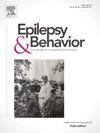A preliminary efficacy study of eye movement desensitisation and reprocessing therapy in reducing epilepsy-related anxiety
IF 2.3
3区 医学
Q2 BEHAVIORAL SCIENCES
引用次数: 0
Abstract
Objective
To determine whether eye movement desensitisation and reprocessing (EMDR) therapy reduces anxiety in people with epilepsy-related anxiety. Secondary outcomes included health-related quality of life (HRQOL), subjective cognitive functioning and seizure frequency.
Methods
Prospective uncontrolled study with a pre-post follow-up design, including measurements before, immediately after, and three months after EMDR therapy, focused on the individuals’ fear of future seizures (i.e. flashforwards). We recruited participants with epilepsy-related anxiety from a Dutch tertiary epilepsy centre. Questionnaires were used to monitor general and epilepsy-related anxiety, HRQOL, subjective cognitive functioning and seizure frequency. Repeated-measures ANOVA was used.
Results
Eleven participants were included. We observed a significant reduction in general and epilepsy-related anxiety from before to immediately after EMDR treatment, and three months hereafter (p ≤ 0.001, η2 = 0.698 and p ≤ 0.001, η2 = 0.641, respectively). This coincided with an improvement in HRQOL (p ≤ 0.001, η2 = 0.550). Despite a main treatment effect for subjective cognitive functioning (p = 0.023, η2 = 0.415), no significant post hoc effects were observed. No effects were found for informant-reported cognitive functioning (p = 0.261, η2 = 0.236) and seizure frequency (p = 0.495, η2 = 0.075).
Conclusion
This study provides preliminary evidence that EMDR therapy reduces anxiety in people with epilepsy-related anxiety. This effect sustained over three months and coincided with an improved HRQOL. Subjective cognitive functioning and seizure frequency did not change over time. Our findings suggest that EMDR therapy is a potentially safe treatment for epilepsy-related anxiety.
眼动脱敏和再加工治疗减轻癫痫相关焦虑的初步疗效研究
目的探讨眼动脱敏和再加工(EMDR)疗法是否能减轻癫痫相关焦虑患者的焦虑。次要结局包括健康相关生活质量(HRQOL)、主观认知功能和癫痫发作频率。方法前瞻性无对照研究,采用前后随访设计,包括EMDR治疗前、治疗后和治疗后三个月的测量,重点关注个体对未来癫痫发作(即闪回)的恐惧。我们从荷兰三级癫痫中心招募了患有癫痫相关焦虑的参与者。使用问卷监测一般焦虑和癫痫相关焦虑、HRQOL、主观认知功能和癫痫发作频率。采用重复测量方差分析。结果纳入6名参与者。我们观察到,从EMDR治疗前到治疗后以及治疗后3个月,患者的一般焦虑和癫痫相关焦虑显著降低(p≤0.001,η2 = 0.698和p≤0.001,η2 = 0.641)。这与HRQOL的改善相吻合(p≤0.001,η2 = 0.550)。尽管对主观认知功能有主要的治疗效果(p = 0.023, η2 = 0.415),但没有观察到显著的事后效应。对举报人报告的认知功能(p = 0.261, η2 = 0.236)和癫痫发作频率(p = 0.495, η2 = 0.075)无影响。结论本研究提供了EMDR治疗减轻癫痫相关焦虑患者焦虑的初步证据。这种效果持续了三个多月,并与HRQOL的改善相吻合。主观认知功能和癫痫发作频率没有随时间变化。我们的研究结果表明,EMDR疗法是一种潜在安全的治疗癫痫相关焦虑的方法。
本文章由计算机程序翻译,如有差异,请以英文原文为准。
求助全文
约1分钟内获得全文
求助全文
来源期刊

Epilepsy & Behavior
医学-行为科学
CiteScore
5.40
自引率
15.40%
发文量
385
审稿时长
43 days
期刊介绍:
Epilepsy & Behavior is the fastest-growing international journal uniquely devoted to the rapid dissemination of the most current information available on the behavioral aspects of seizures and epilepsy.
Epilepsy & Behavior presents original peer-reviewed articles based on laboratory and clinical research. Topics are drawn from a variety of fields, including clinical neurology, neurosurgery, neuropsychiatry, neuropsychology, neurophysiology, neuropharmacology, and neuroimaging.
From September 2012 Epilepsy & Behavior stopped accepting Case Reports for publication in the journal. From this date authors who submit to Epilepsy & Behavior will be offered a transfer or asked to resubmit their Case Reports to its new sister journal, Epilepsy & Behavior Case Reports.
 求助内容:
求助内容: 应助结果提醒方式:
应助结果提醒方式:


